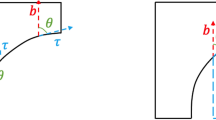Abstract
Advances in additive manufacturing technology (AMT) enable the direct fabrication of thermally conductive molds with heat sinks or conformal cooling channels. Although tool steels (e.g., P21, H13, SUS420J2) are popularly used as die materials because of high dimensional stability, tool steels are inefficient for cooling mold dies due to low thermal conductivity. Hence, the adoption of functionally graded tool steel/Cu materials (FGMs) has good potentials for thermally conductive molds to avoid thermal stress concentration while improving thermal conductivity. In this sense, this paper presents a new method for the representation and analysis of conformal cooling channels in molds (injection or blowing) made of functionally graded tool steel/Cu materials. A heterogeneous sweep operation combined with 2D material blending was proposed to construct heterogeneous solid models for conformal cooling channels. In addition, one-dimensional P21/Cu FGMs were fabricated using DMT (laser-aided direct metal tooling). Material properties (such as density, specific heat, thermal conductivity, coefficient of thermal expansion, and hardness) were evaluated to obtain more accurate analysis results and to verify the feasibility of such a multi-functional mold. An example is shown to illustrate the entire representation and analysis procedure.
Similar content being viewed by others
References
D. E. Dimla, M. Camilotto and F. Miani, Design and optimization of conformal cooling channels in injection moulding tools, Journal of Material Processing Technology, 164–165 (2005) 1294–1300.
D. G. Ahn and H. W. Kim, Study on the manufacture of a thermal management mould with three different materials using a direct metal tooling rapid tooling process, Proceedings of the institution of Mechanical Engineers, Part B: Journal of Engineering Manufacture, 224(B3) (2010) 385–402.
L. Q. Tang, C. Chassapis and S. Manoochehri, Optimal cooling system design for multi-cavity injection moulding, Finite Elements in Analysis and Design, 26(3) (1997) 229–251.
C. L. Li, A feature-based approach to injection mould cooling system design, Computer-Aided Design, 33(14) (2001) 1073–1090.
K. H. Shin, H. Natu, D. Dutta and J. Mazumder, A method for the design and fabrication of heterogeneous objects, Materials & Design, 24(5) (2003) 339–353.
S. M. Thompson, L. Bian, N. Shamsaei and A. Yadollahi, An overview of direct laser deposition for additive manufacturing: Part I: Transport phenomena, modeling and diagnostics, Additive Manufacturing, 8 (2015) 36–62.
X. Yao, S. K. Moon and G. Bi, Multidisciplinary design optimization to identify additive manufacturing resources in customized product development, Journal of Computational Design and Engineering, 4(2) (2017) 131–142.
H. S. Kim and K. H. Shin, Material pixel-based process planning for layered manufacturing of heterogeneous objects, International Journal of Precision Engineering and Manufacturing, 15(11) (2014) 2421–2427.
V. E. Beal, P. Erasenthiran, N. Hopkinson, P. Dickens and C. H. Ahrens, The effect of scanning strategy on laser fusion of functionally graded H13/Cu materials, International Journal of Advanced Manufacturing Technology, 30(9–10) (2006) 844–852.
V. E. Beal, P. Erasenthiran, N. Hopkinson, P. Dickens and C. H. Ahrens, Optimisation of processing parameters in laser fused H13/Cu materials using response surface method(RSM), Journal of Materials Processing Technology, 174(1–3) (2006) 145–154.
U. Articek, M. Milfelner and I. Anzel, Synthesis of functionally graded material H13/Cu by LENS technology, Advances in Production Engineering & Management, 8(3) (2013) 169–176.
K. H. Shin, Modeling of cooling channels of injection mould using functionally graded material, Transactions of KSME (A), 35(12) (2011) 1647–1653.
J. S. Jeong and K. H. Shin, Fabrication of functionally graded materials between P21 tool steel and Cu by using laser-aided layered manufacturing, Transactions of KSME (A), 37(1) (2013) 61–66.
J. Fessler, A. Nickel, G. Link, F. Prinz and P. Fussell, Functional gradient metallic prototypes through shape deposition manufacturing, Proceedings of the 1997 Solid Freeform Fabrication Symposium, Austin, TX (1997) 521–528.
E. Sachs, E. Wylonis, S. Allen, M. Cima and H. Guo, Production of injection molding tooling with conformal cooling channels using the three dimensional printing process, Polymer Engineering & Science, 40(5) (2000) 1232–1247.
J. Mazumder, D. Dutta, N. Kikuchi and A. Ghosh, Closed loop direct metal deposition: art to part, Optics and Lasers in Engineering, 34 (2000) 397–414.
S. Suresh and A. Mortensen, Functionally graded metals and metal-ceramic composites: Thermomechanical behavior, International Materials Reviews, 42 (1997) 85–116.
J. R. Zuiker, Functionally graded materials: Choice of micromechanics model and limitations in property variation, Composites Engineering, 5(7) (1995) 807–819.
K. H. Shin and D. Dutta, Constructive representation of heterogeneous objects, Journal of Computing and Information Science in Engineering, 1(3) (2001) 205–217.
S. Bhashyam, K. H. Shin and D. Dutta, An integrated CAD system for design of heterogeneous objects, Rapid Prototyping Journal, 6 (2000) 119–135.
K. H. Shin, Modeling of time-variant heterogeneous objects in micro-system packages, Journal of Mechanical Science and Technology, 25(5) (2011) 1119–1128.
ACIS Geometric Modeler: Application Guide, Spatial Technology Inc. (2002).
F. P. Incropera and D. P. DeWitt, Fundamentals of Heat and Mass Transfer, 4th Edition, John Wiley & Sons, New York (1996) 443–449.
A. B. M. Saifullah and S. H. Masood, Finite element thermal analysis of conformal cooling channels in injection moulding, Proceedings of the 5th Australasian Congress on Applied Mechanics (ACAM 2007), Brisbane, Australia (2007) 337–341.
Author information
Authors and Affiliations
Corresponding author
Additional information
Recommended by Associate Editor Beomkeun Kim
Ki-Hoon Shin received his B.S. and M.S. degrees in mechanical design & production engineering from Seoul National University, Korea and earned his Ph.D. in mechanical engineering from University of Michigan, Ann Arbor, USA. He is currently a Professor in the Department of Mechanical and Automotive Engineering at Seoul National University of Science and Technology. His research interests are in CAD/CAM/CAE and laser-aided additive manufacturing of heterogeneous objects such as FGMs.
Rights and permissions
About this article
Cite this article
Shin, KH. A method for representation and analysis of conformal cooling channels in molds made of functionally graded tool steel/Cu materials. J Mech Sci Technol 33, 1743–1750 (2019). https://doi.org/10.1007/s12206-019-0326-x
Received:
Revised:
Accepted:
Published:
Issue Date:
DOI: https://doi.org/10.1007/s12206-019-0326-x




